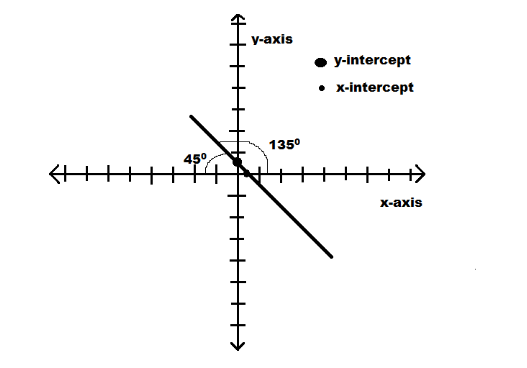
How do you graph using slope and intercept of the given linear equation, the equation is \[y = - x + \dfrac{3}{2}\] ?
Answer
538.5k+ views
Hint: Slope is the angle from the positive axis of the graph to the line drawn; it gives the angle of inclination of the graph. To find the slope of any line you can use the trigonometric identity of “tanx” and can get the angle of slope by using it.
Complete step-by-step answer:
The given equation is \[y = - x + \dfrac{3}{2}\]
According to the question we have to find the slope and intercept of the curve given, lets first find the slope of the graph:
For finding slope we are using here the differentiation method of finding slope, in which we have to differentiate the equation as \[\dfrac{{dy}}{{dx}}\]
Now the value of “y” from the equation is:
\[
\Rightarrow y = - x + \dfrac{3}{2} \;
\]
Now on differentiating the term we get:
\[
\Rightarrow \dfrac{{dy}}{{dx}} = \dfrac{d}{{dx}}\left( { - x + \dfrac{3}{2}} \right) \\
\Rightarrow \dfrac{{dy}}{{dx}} = - 1 \\
\]
Hence we find the required slope of the given equation and for finding the angle we can use trigonometric identity that is:
\[ \Rightarrow \tan (\theta ) = - 1 \Rightarrow \theta = {\tan ^{ - 1}}( - 1) = 135\,\deg ree\,from\,positive\,x\,axis\,and\,45\,\deg ree\,from\,negative\,x\,ais\]
Now for finding the intercept we have to rearrange the equation as, the general equation which is:
\[ \Rightarrow \dfrac{x}{a} + \dfrac{y}{b} = 1\,(here\,a\,and\,b\,are\,\operatorname{int} ercept\,of\,the\,given\,equation)\]
Rearranging our equation we get:
\[
\Rightarrow \dfrac{x}{{\dfrac{3}{2}}} + \dfrac{y}{{\dfrac{3}{2}}} = 1(dividing\,by\,10\,both\,the\,sides\,of\,the\,equation) \\
\Rightarrow \dfrac{{2x}}{3} + \dfrac{{2y}}{3} = 1 \\
\Rightarrow \operatorname{int} ercept\,are\,\dfrac{2}{3},\dfrac{2}{3}\,for\,x\,and\,y\,respectively \;
\]
Here we obtained the slope and intercept, now we can plot the graph.

Note: Here it was easy to rearrange the equation in the general form of the intercept equation but if this rearrangement is not possible then you have to plot the graph and the n check the points on which are curve is cutting the both axes and that coordinates are our required intercepts.
Complete step-by-step answer:
The given equation is \[y = - x + \dfrac{3}{2}\]
According to the question we have to find the slope and intercept of the curve given, lets first find the slope of the graph:
For finding slope we are using here the differentiation method of finding slope, in which we have to differentiate the equation as \[\dfrac{{dy}}{{dx}}\]
Now the value of “y” from the equation is:
\[
\Rightarrow y = - x + \dfrac{3}{2} \;
\]
Now on differentiating the term we get:
\[
\Rightarrow \dfrac{{dy}}{{dx}} = \dfrac{d}{{dx}}\left( { - x + \dfrac{3}{2}} \right) \\
\Rightarrow \dfrac{{dy}}{{dx}} = - 1 \\
\]
Hence we find the required slope of the given equation and for finding the angle we can use trigonometric identity that is:
\[ \Rightarrow \tan (\theta ) = - 1 \Rightarrow \theta = {\tan ^{ - 1}}( - 1) = 135\,\deg ree\,from\,positive\,x\,axis\,and\,45\,\deg ree\,from\,negative\,x\,ais\]
Now for finding the intercept we have to rearrange the equation as, the general equation which is:
\[ \Rightarrow \dfrac{x}{a} + \dfrac{y}{b} = 1\,(here\,a\,and\,b\,are\,\operatorname{int} ercept\,of\,the\,given\,equation)\]
Rearranging our equation we get:
\[
\Rightarrow \dfrac{x}{{\dfrac{3}{2}}} + \dfrac{y}{{\dfrac{3}{2}}} = 1(dividing\,by\,10\,both\,the\,sides\,of\,the\,equation) \\
\Rightarrow \dfrac{{2x}}{3} + \dfrac{{2y}}{3} = 1 \\
\Rightarrow \operatorname{int} ercept\,are\,\dfrac{2}{3},\dfrac{2}{3}\,for\,x\,and\,y\,respectively \;
\]
Here we obtained the slope and intercept, now we can plot the graph.

Note: Here it was easy to rearrange the equation in the general form of the intercept equation but if this rearrangement is not possible then you have to plot the graph and the n check the points on which are curve is cutting the both axes and that coordinates are our required intercepts.
Recently Updated Pages
Master Class 12 Business Studies: Engaging Questions & Answers for Success

Master Class 12 Economics: Engaging Questions & Answers for Success

Master Class 12 English: Engaging Questions & Answers for Success

Master Class 12 Maths: Engaging Questions & Answers for Success

Master Class 12 Social Science: Engaging Questions & Answers for Success

Master Class 12 Chemistry: Engaging Questions & Answers for Success

Trending doubts
What is meant by exothermic and endothermic reactions class 11 chemistry CBSE

Which animal has three hearts class 11 biology CBSE

10 examples of friction in our daily life

One Metric ton is equal to kg A 10000 B 1000 C 100 class 11 physics CBSE

1 Quintal is equal to a 110 kg b 10 kg c 100kg d 1000 class 11 physics CBSE

Difference Between Prokaryotic Cells and Eukaryotic Cells




